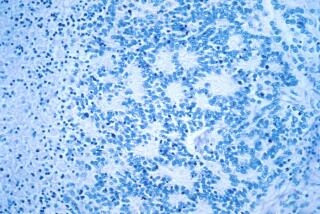Gene Therapy Link to Cancer Is Traced
- Share via
WASHINGTON — Gene therapy saved the lives of two French “bubble boys” but later gave them leukemia by activating a cancer-causing gene, researchers said Thursday.
The experimental treatment triggered a gene that caused bone marrow in the boys to overproduce immune system cells called T-cells, the international team of researchers reported.
This had been the theory about why the boys developed cancer. Both have been successfully treated with chemotherapy, according to the French doctors who are caring for them.
The boys are among a group of 10 treated for a rare genetic defect called “X-linked severe combined immunodeficiency” or SCID-X1. It is caused by a defective gene and affects only boys because girls have a second copy of the X chromosome, which can make up for the defective copy.
Their doctors used a virus to carry in a gene to replace the defective gene with a working copy. The boys had seemingly been cured of SCID before the leukemia symptoms began. They were among nine gene therapy patients in France who had been living virtually normal lives.
But by the time the boys turned 3, the French researchers, led by Dr. Alain Fischer of Necker Hospital in Paris, found that the patients were developing symptoms of leukemia.
Writing in the journal Science, Fischer and colleagues said they had confirmed that the virus carrying the therapeutic genes had inserted itself into the boys’ DNA right next to a gene called LMO2, which in turn became improperly activated.
In February, the U.S. Food and Drug Administration limited certain experimental gene therapy trials to only children who were otherwise certain to die, saying such procedures risked swapping one dreaded disease for another.
The French cases are the most serious setback to the field of gene therapy since Jesse Gelsinger, 18, died in the U.S. in 1999 after receiving experimental gene therapy for a liver disorder.
The question is whether the risk of cancer outweighs the risk from gene therapy, which is often a patient’s only hope.
Childhood leukemia is generally easy to treat, with cure rates of 90% or more. In contrast, children with SCID who cannot get a bone-marrow transplant almost always die within a year.






